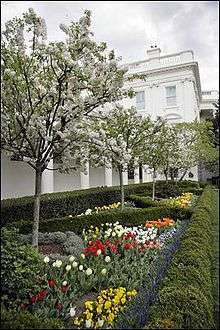Lincoln Bedroom

The Lincoln Bedroom is a bedroom which is part of a guest suite located in the southeast corner of the second floor of the White House in Washington, D.C. The Lincoln Sitting Room makes up the other part of the suite. The room is named for President Abraham Lincoln, who used the room as an office.
The first room in the White House to carry the name "Lincoln Bedroom" was in the northwest corner of the White House. It existed from 1929 until the 1961, when First Lady Jacqueline Kennedy transformed it into the President's Dining Room.
Prior history

Anonymous bedchambers: 1809-1824
The Lincoln Bedroom and the Lincoln Sitting Room are located in the southeast corner of the Second Floor. As originally designed and completed in 1809, this space contained two very narrow, north-south running bedchambers with a toilet room between them.[1]
The President's Office: 1825-1945
By 1825, the toilet had been removed and the bathroom space joined to the west bedchamber to create an office.[2] This area was used for the President's office over the next several decades. Abraham Lincoln used it as both an office and a Cabinet room, and signed the Emancipation Proclamation in the room on January 1, 1863.[3] During the Lincoln presidency, the walls were covered with Civil War maps. It had dark green wallpaper, and the carpeting was also dark green. Newspapers were stacked on the desk and tables along with large amounts of mail and requests from office seekers. Two large wicker wastebaskets were filled with debris. The east bedchamber was converted into an office for presidential aides, although President John Tyler used it as part of his office from 1841 to 1845.[4]
The Blue Bedroom: 1945-1961
In 1945, newly inaugurated President Harry S. Truman learned that the "President's Office" had once been used by Abraham Lincoln. Truman had the bed, furniture, and other items in the Prince of Wales Room moved into the office. The new bedroom was decorated primarily in blue, and became briefly known as the "Blue Bedroom." The White House underwent a complete structural rehabilitation beginning in 1952, during which the rooms were rebuilt.[5]
The Lincoln Bedroom: Post-1961
Jacqueline Kennedy renovated much of the White House during the Kennedy administration, including the Lincoln Bedroom. These changes included adding an unsigned portrait of a Hartford, Connecticut, family in their parlor to what was now known as the Lincoln Bedroom. This unsigned oil painting, dated 1840 to 1850, was donated by the E. and A. Silberman Galleries.[6]
Clinton renovation
During the Clinton administration the Committee for the Preservation of the White House and then Curator of the White House Betty Monkman began initial assessment for the refurbishment of the room. While most of the furniture and artwork in the room was found to be of similar related periods, and much was associated with the presidency of Lincoln, the room's carpeting, mantel and anemic painted walls were not of the period. Initial decisions were made to replace the existing Neoclassical mantel with a mid-19th-century style mantel design, and to use more pattern as would have been used in Lincoln's day for the wallpaper and carpet. Two etchings and a drawing consistently showed a diamond patterned wallpaper and a Renaissance Revival style gas chandelier. A small oil painting showed a color representation of the same diamond patterned wall paper in dark green, mustard and teal.
George W. Bush renovation
During the administration of George W. Bush the new curator, William Allman along with new Bush appointees to the Committee for the Preservation of the White House, including Bush family decorator Ken Blasingame, continued with the process. A boldly patterned Renaissance Revival patterned carpet was created for the room. The wallpaper became a compromise, using the diamond pattern found in the historic engravings and painting, but eschewing the deep Victorian color palette found in the oil painting, for a much lighter off-white color favored by the Bush family in many of the White House rooms they refurbished.
The crown-shaped canopy hood which originally held the canopy of the Lincoln bed was recreated, and the lace and silk and wool velvet bed drapes were accurately recreated, including hand-made fringe and tassels based upon 19th-century photographs. New gilded window valances in the Rococo Revival style, perhaps intended to echo the bed canopy crown were created in place of those shown in engravings, drawings and a painting made during Lincoln's presidency.
See also
References
- ↑ Phillips-Schrock 2013, p. 148.
- ↑ Phillips-Schrock 2013, p. 157.
- ↑ Kalb 2013, pp. 1336-1337.
- ↑ Kalb 2013, p. 1337.
- ↑ Klara 2013, p. 19.
- ↑ Abbott & Rice 1998, p. 30.
Bibliography
- Abbott, James A.; Rice, Elaine M. (1998). Designing Camelot: The Kennedy White House Restoration. New York: Van Nostrand Reinhold. ISBN 9780442025328.
- Kalb, Deborah (2013). "Housing of the Executive Branch". In Nelson, Michael. Guide to the Presidency and the Executive Branch. Thousand Oaks, Calif.: CQ Press. ISBN 156802018X.
- Klara, Robert (2013). The Hidden White House: Harry Truman and the Reconstruction of America's Most Famous Residence. New York: Thomas Dunne Books. ISBN 9781250000279.
- Monkman, Betty C. (2000). The White House: The Historic Furnishings and First Families. Washington, D.C.: White House Historical Association. ISBN 0789206242.
- Phillips-Schrock, Patrick (2013). The White House: An Illustrated Architectural History. Jefferson, N.C.: McFarland & Company. ISBN 9780786471522.
Further reading
- Time: "The Origins of the Lincoln Bedroom"
- Washington Post: "Lincoln Bedroom's Sleepy Look to Get A Wake-Up Call"
External links
| Wikimedia Commons has media related to Lincoln Bedroom. |
- White House Historical Association: The Lincoln Bed
- White House Museum: The Lincoln Bedroom
- Lincoln Bedroom
Coordinates: 38°53′51″N 77°02′11″W / 38.897617°N 77.036363°W


